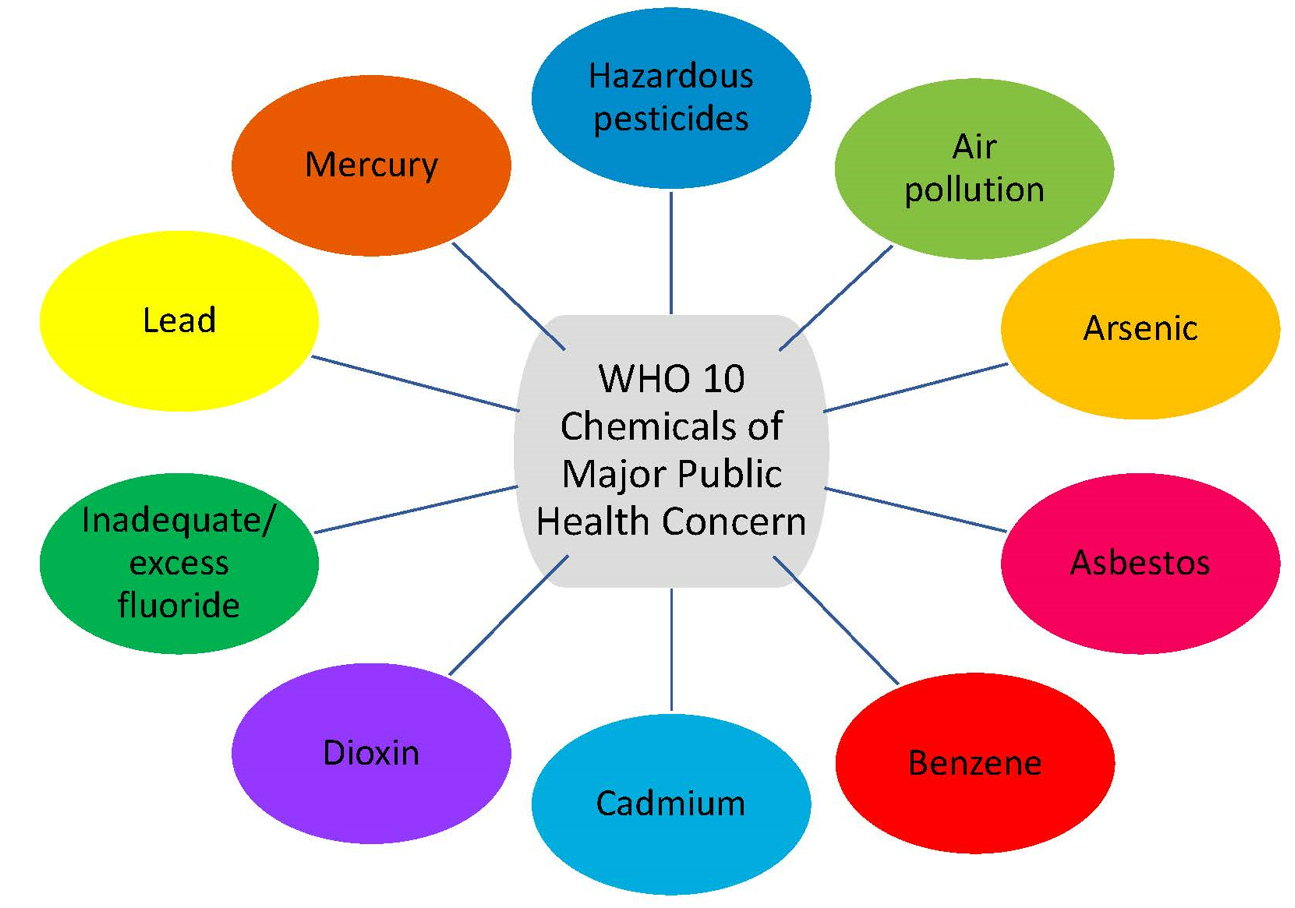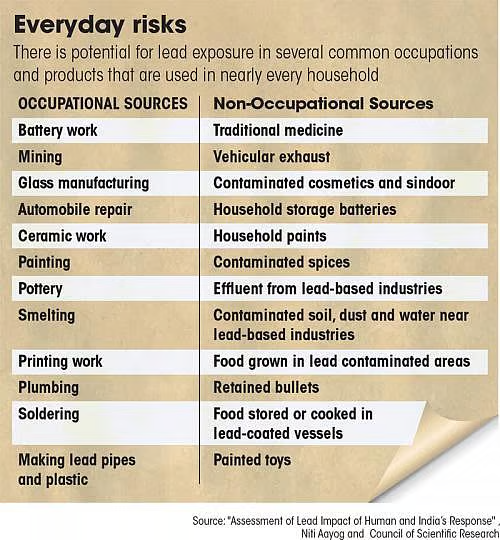Biodiversity & Environment
Lead Poisoning
- 27 Mar 2025
- 9 min read
Prelims: Lead, Lead Poisoning, Plumbism, Saturism, Anaemia, Heavy Metal, United Nations Environment Programme, Central Pollution Control Board (CPCB).
Mains: Environmental Pollution & Degradation, Lead Poisoning and related concerns
Why in News?
Lead poisoning remains a significant but overlooked public health crisis in India, particularly affecting children. While multiple laws regulate lead contamination across sectors, the absence of a comprehensive legal framework for its prevention and mitigation hinders effective enforcement and policy coherence.
Lead
- Lead is a toxic, naturally occurring heavy metal characterized by its softness, malleability, and bluish-white luster, with no safe level of exposure identified.
- WHO identifies lead as one of 10 chemicals of major public health concern.
- In 2021, WHO issued guidelines recommending that individuals with blood lead levels ≥5 µg/dL should be assessed for exposure sources, and steps taken to eliminate them.
- Lead-based paint continues to be a major global source of lead exposure. WHO and UNEP’s Global Alliance to Eliminate Lead Paint urges countries to implement legal restrictions; however, as of January 2024, only 48% have enacted such laws.
What is Lead Poisoning?
- About: Lead poisoning (also known as Plumbism and Saturism) occurs when lead accumulates in the body over time, typically over months or years, leading to toxic effects.
- Status of Lead Poisoning: Lead is poisoning 1/3 of all children globally.
- A 2020 UNICEF-Pure Earth report found that half of India's children have high blood lead levels (BLL). About 275 million children exceed the WHO’s safe limit (5 μg/dL), and 64.3 million have even higher levels (above 10 μg/dL).
- CSIR-NITI Aayog Report: 23 states exceed the recommended 5 µg/dL BLL limit.
- Approximately 5% of India’s GDP loss due to lead poisoning.
- Sources:
- Symptoms & Effects: Symptoms include fatigue, abdominal pain, nausea, diarrhoea, loss of appetite, anemia, muscle weakness, and a characteristic dark line along the gums.
What is Mercury Poisoning?Click Here to Read: Mercury Poisoning |
What are the Policy Measures to Combat Lead Poisoning in India?
- Existing Policy Measures/ Legal Provisions:
- Ban on Leaded Petrol (2000): India phased out leaded petrol, reducing airborne lead pollution, health risks, and environmental damage. This transition also helped reduce engine knocking, improving vehicle efficiency and engine longevity, aligning with global efforts for cleaner fuel and better air quality.
|
Regulations |
Provisions |
|
Environment Protection Act, 1986 |
It empowers the central government (CPCB) to regulate lead contamination by setting permissible limits for effluents and pollutants. |
|
Factories Act, 1948 |
It ensures worker health and safety, indirectly addressing lead poisoning in industries using lead. Chapter III focuses on worker safety, welfare, and hygiene.
|
|
The Code of Practice for Water Supply in Buildings, 1957 |
It prohibits lead pipes for domestic water supply, setting a 10 µg/L lead limit in water. However, it permits lead piping for flushing and overflow systems.
|
|
Insecticides Act, 1968 |
It regulates the import, manufacture, sale, and use of insecticides for safety and efficacy.
|
|
Food Safety and Standards Act, 2006 |
It empowers FSSAI to regulate food safety and set lead limits in food (e.g.,turmeric (10), leafy vegetables (0.3), pulses (0.2), sugar (5.0), infant Food (0.2), etc.) and drinking water (0.01 mg/L as per BIS).
|
|
Hazardous Waste Management Rules, 2016 |
It classifies lead-containing waste and regulates its storage, treatment, and disposal, requiring industries to obtain SPCB/PCC authorization.
|
|
Drugs and Cosmetics Act, 1940 |
These set a lead limit of 20 ppm in cosmetics, mandating compliance for manufacturers and importers with proper ingredient labeling. |
|
The Child Labour Act, 1986 |
It helps mitigate lead poisoning by prohibiting child labor in hazardous environments. |
|
Bureau of Indian Standards Act, 2016 |
It designates BIS as India's National Standards Body, ensuring standardization, marking, and quality certification of goods.
|
What are the Challenges to Implementation in Lead Regulations?
- Lead in Insecticides: The Insecticides Act, 1968, still lists Lead Arsenate as an insecticide, despite its ban under the 2019 list of prohibited pesticides by the Ministry of Agriculture due to health and environmental risks.
- Lead in Food Products: FSSAI has banned Lead Chromate in turmeric but allows lead content up to 10 ppm, creating a regulatory loophole that permits trace lead contamination despite the ban.
- Lead in Paints: The 2016 rules limit lead in new paints but do not address existing lead-based paint in homes.
- Water Contamination: Weak enforcement of the Code of Practice for Water Supply in Buildings (1957) and Lead Stabilizers in PVC Pipes Rules (2021).
Way Forward
- Stronger Legal Framework: Introduce a dedicated set of rules under the Environment Protection Act (EPA), 1986, regulating lead production, recycling, and disposal to ensure comprehensive legal coverage.
- Establish a Safe Blood Lead Level (BLL): Define and implement a national threshold for BLL in line with WHO recommendations to guide policy interventions.
- Occupational Safety Standards: Adopt global best practices such as US’ Occupational Safety and Health Administration (OSHA) regulations and the UK’s Control of Lead at Work Regulations (2002) to protect workers in lead-related industries.
- Stricter Enforcement: Establish clear penalties for non-compliance, particularly in industries, water supply, and toy manufacturing, aligning with EU Toy Safety Directive standards.
- Public Awareness & Market Incentives: Promote lead-free products through tax incentives and large-scale public awareness campaigns to encourage safer alternatives.
Conclusion
To combat lead poisoning effectively, a comprehensive regulatory framework, stricter enforcement, and public awareness initiatives are essential. Given its severe health risks, lead poisoning must be treated as a top public health priority in India.
UPSC Civil Services Examination, Previous Year Questions (PYQs)
Q. Lead, ingested or inhaled, is a health hazard. After the addition of lead to petrol has been banned, what still are the sources of lead poisoning? (2012)
- Smelting units
- Pens and pencils
- Paints
- Hair oils and cosmetics
Select the correct answer using the codes given below:
(a) 1, 2 and 3 only
(b) 1 and 3 only
(c) 2 and 4 only
(d) 1, 2, 3 and 4
Ans: (b)







